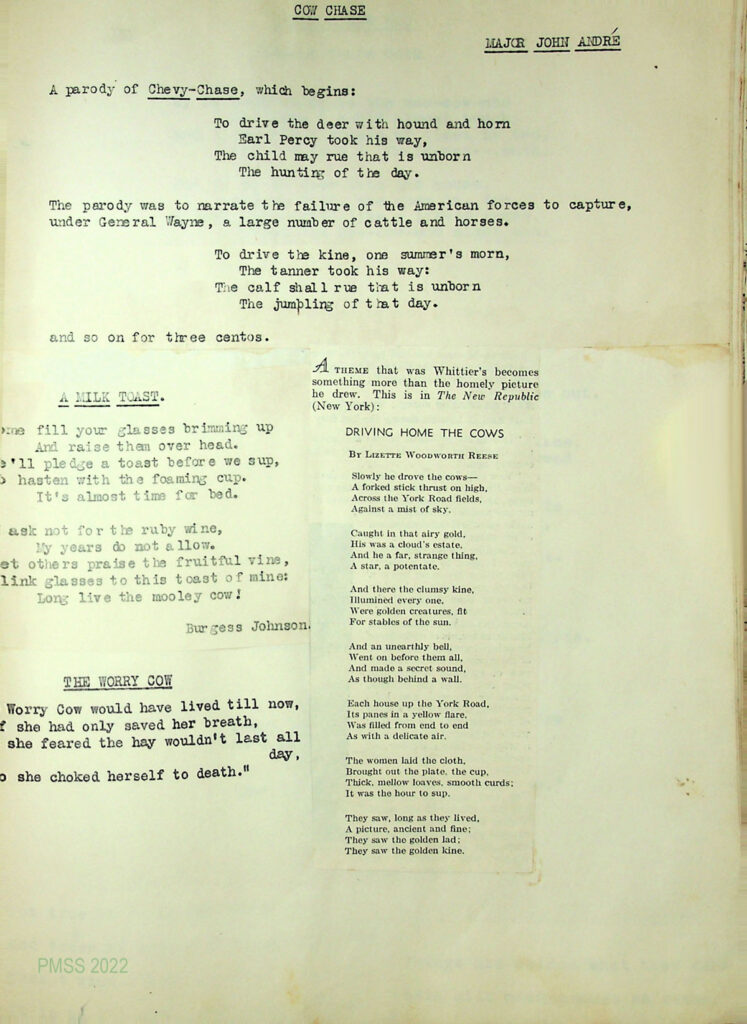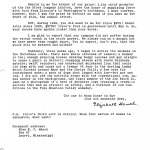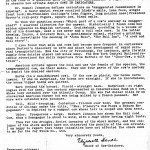Pine Mountain Settlement School
Series 02: GOVERNANCE – Board of Trustees
Series 11: FARM
Elizabeth Hench, Trustee, 1914-1931(?)
Joy Stock Company Limited Letters 1930

A page from Elizabeth Hench’s scrapbook on cows. [hench_scrapbk_00001.jpg]
ELIZABETH HENCH Joy Stock Company Limited Letters 1930
CONTENTS
January 1930 [hench_0008.jpg]
Elizabeth Hench, Joy Stock Co., Ltd., Joyce, fundraising, receipts, Christmas card animals, Ayrshire cows, Overjoy cow, Miss Elizabeth C. Hench, Laurel, MS
October 1930 [hench_0009.jpg]
Dr. Samuel Johnston, Charles Lindbergh, President Coolidge, President Hoover, cow’s anatomy in caricatures, cows, milk, and bulls in English cartoons, Cruikshank, railroads, American cartoonists, Elizabeth Hench, Laurel, MS
**********
For a description of the arrival of the Ayrshire cow, Joyce, at Pine Mountain Settlement School, go to Hench’s 1927 letter at ELIZABETH HENCH Joy Stock Company Limited Letter 1927.
TRANSCRIPTION – January 1930 [hench_0008.jpg]
January, 1930
Dear Lady or Gentleman:
Behold in me the winner of our prize! I, the chief promoter of the Joy Stock Company Limited, have the honor of supplying Joyce with food from Lincoln’s to Washington’s birthdays. I must confess, however, that I won the prize by default as none of you sent me the draft of this, the annual letter.
BUT, during 1929, you did send to me for Joyce $278! Grand total since 1920, $2752! Joyce’s food is guaranteed until May 8. So, your checks have spoken louder than your words.
I am glad to report that our company did not suffer during the recent crash in the stock market. We always run on a margin but we have never been caught short. You do expect, don’t you, that the stock will be watered and milked?
Suddenly, three weeks ago, I began to notice the animals on the Christmas cards. There were whole caravans of camels; a donkey or two; enough prancing horses drawing bumpy coaches and gay sleighs to cause a panic in Detroit; champing steeds with brave Galahads astride; swift reindeer; one benevolent whiskered lion that could lie down with and cause not a tremor of fear to the darling lambs which flocked around Mary and the Christ Child; a few cats for contentment sake; a pack of dogs that leaped with joy — but not one cow. I did not see one nativity scene with the conventional cow, ox, and donkey in the back-ground. One loyal member of the Joy Stock Co. sent me a photograph of a herd of Ayrshire cows crossing a creek — a picture that was as artistic as lovely, and a forecast of cow conditions in the Pine Mountain valley someday.
The one to whom honor is due
(but not mountain dew),
[signed] Elizabeth Hench.
P.S. Joyce’s third calf is Overjoy. When that series of names is exhausted, what next?
Miss E. C. Hench
Laurel, Mississippi
TRANSCRIPTION – October 1930 [hench_0009.jpg]
October, 1930
Dear Friend:
Last winter my attention was suddenly arrested by a cow’s horns in a funny picture. One horn was curled inward according to nature, the other was in the form of a question mark to indicate incredulity. I began immediately to observe how artists depict COWS IN CARICATURE.
Dr. Samuel Johnston defines caricature as “exaggerated resemblance in drawing”. A hasty mental review recalled Lindy’s [Charles Lindbergh] smile, lean face, single front lock; Ex-President Coolidge’s lean figure, long pointed nose; President Hoover’s roly-poly figure, square jaw, bland smile.
So then the question arose; “Which part of a cow’s anatomy is exaggerated?” I searched libraries for the answer. Historically I found cows had seldom appeared in English cartoons. Cruikshank, according to a volume of 400 of his drawings, used a cow never and bull only once. In the latter drawing, Taurus, a Literary Bull, a gentlemanly animal, visited a printing shop to investigate the meaning of “John Bull”, “The Bull Inn”, “A cock and bull story”.
I also found that milk and cows had become more frequent in caricature since Pasteur’s discovery in 1876 and since the development of rapid railroad transportation. Now the city of Pittsburgh, for instance, gets its milk supply from dairies almost 140 miles away. The New York Central Railroad recently advertised the daily departure from Buffalo of the “Choo-Cow, a milk train”.
American artists ignore the bull and use the female of the species, the temperamental cow, as their model. They use four parts of the cow’s anatomy to depict the desired emotion.
Horns (in a non-dehorned cow). If the cow is placid, the horns curve inward. If she is surprised, the horns are straight. If she is incredulous, the brass-tipped horns are quirked.
Ears (behind the horns). Placid — straight back. Surprised — at right angles with the head. One cartoon represented an International Bank as a cow, whose body extended over the Atlantic Ocean. She was fed dollar bills by an overworked American farmer but was being milked by a French peasant. Her ears were extended with pleasure.
Tail. Mild — drooping. Contented — flicked over body. The present condition of Chicago under the title, “Mrs. O’Leary’s Cow Plays a Return Engagement” is depicted by a rampant cow whose tail is looped and then erect.
Udder. Prosperous — large. Herbert Johnson has shown the Railroad Cow, whom a Demagogue is about to milk, with a huge udder having eight teats.
Thus far the drought, Soviet invasion of the wheat market, and the collapse of the stock market have not attracted the pencils of the cow artists. I am happy to report that these calamities have not affected the check sent to me for the Joy Stock Co., Ltd.
Very sincerely your,
[Signed] Elizabeth Hench
Chief of Cow-Catchers.
Permanent address:
Miss E. C. Hench
Laurel, Mississippi
GALLERY: ELIZABETH HENCH Joy Stock Company Limited Letters 1930
- Cow Letters, Jan 1930. hench_0008.jpg
- Cow Letters, Oct 1930. hench_0009.jpg
Return To:
ELIZABETH HENCH
ELIZABETH HENCH GUIDE Joy Stock Company Limited Letters 1927-1933
ELIZABETH HENCH SCRAPBOOK Joy Makes History



